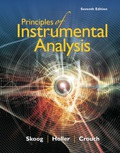
Principles of Instrumental Analysis
7th Edition
ISBN: 9781337468039
Author: Skoog
Publisher: Cengage
expand_more
expand_more
format_list_bulleted
Question
Chapter 13, Problem 13.16QAP
Interpretation Introduction
Interpretation:
The reason for the continuum spectrum produced by a deuterium lamp instead of a line spectrum for the ultraviolet rays should be determined.
Concept introduction:
A continuum spectrum is a spectrum in which the two spectrums line and band spectrum are superimposed over one another. The continuum spectrum is a combined result of several atomic as well as molecular oscillations.
Expert Solution & Answer
Trending nowThis is a popular solution!

Students have asked these similar questions
2. Propose an efficient synthesis for each of the following transformations. Pay
careful attention to both the regio and stereochemical outcomes. ¡
H H
racemic
Zeroth Order Reaction
In a certain experiment the decomposition of hydrogen iodide on finely divided gold is zeroth order with respect to HI.
2HI(g) Au H2(g) + 12(9)
Rate =
-d[HI]/dt k = 2.00x104 mol L-1 s-1
If the experiment has an initial HI concentration of 0.460 mol/L, what is the concentration of HI after 28.0 minutes?
1 pts
Submit Answer Tries 0/5
How long will it take for all of the HI to decompose?
1 pts
Submit Answer Tries 0/5
What is the rate of formation of H2 16.0 minutes after the reaction is initiated?
1 pts
Submit Answer Tries 0/5
angelarodriguezmunoz149@gmail.com
Hi i need help with this question i am not sure what the right answers are.
Chapter 13 Solutions
Principles of Instrumental Analysis
Ch. 13 - Prob. 13.1QAPCh. 13 - Prob. 13.2QAPCh. 13 - Prob. 13.3QAPCh. 13 - Prob. 13.4QAPCh. 13 - Prob. 13.5QAPCh. 13 - Prob. 13.6QAPCh. 13 - Prob. 13.7QAPCh. 13 - At 580 nm, which is the wavelength of its maximum...Ch. 13 - Prob. 13.9QAPCh. 13 - Zinc(II) and the ligand L form a 1:1 complex that...
Ch. 13 - The equilibrium constant for the conjugate...Ch. 13 - The equilibrium constant for the reaction...Ch. 13 - Prob. 13.13QAPCh. 13 - Prob. 13.14QAPCh. 13 - Prob. 13.15QAPCh. 13 - Prob. 13.16QAPCh. 13 - Prob. 13.17QAPCh. 13 - Prob. 13.18QAPCh. 13 - Prob. 13.19QAPCh. 13 - Prob. 13.20QAPCh. 13 - Prob. 13.21QAPCh. 13 - Prob. 13.22QAPCh. 13 - Prob. 13.23QAPCh. 13 - Prob. 13.24QAPCh. 13 - Prob. 13.25QAPCh. 13 - Prob. 13.26QAPCh. 13 - Prob. 13.27QAP
Knowledge Booster
Similar questions
- Saved v Question: I've done both of the graphs and generated an equation from excel, I just need help explaining A-B. Below is just the information I used to get the graphs obtain the graph please help. Prepare two graphs, the first with the percent transmission on the vertical axis and concentration on the horizontal axis and the second with absorption on the vertical axis and concentration on the horizontal axis. Solution # Unknown Concentration (mol/L) Transmittance Absorption 9.88x101 635 0.17 1.98x101 47% 0.33 2.95x101 31% 0.51 3.95x10 21% 0.68 4.94x10 14% 24% 0.85 0.62 A.) Give an equation that relates either the % transmission or the absorption to the concentration. Explain how you arrived at your equation. B.) What is the relationship between the percent transmission and the absorption? C.) Determine the concentration of the ironlll) salicylate in the unknown directly from the graph and from the best fit trend-line (least squares analysis) of the graph that yielded a straight…arrow_forwardDon't used Ai solutionarrow_forwardCalculate the differences between energy levels in J, Einstein's coefficients of estimated absorption and spontaneous emission and life time media for typical electronic transmissions (vnm = 1015 s-1) and vibrations (vnm = 1013 s-1) . Assume that the dipolar transition moments for these transactions are in the order of 1 D.Data: 1D = 3.33564x10-30 C m; epsilon0 = 8.85419x10-12 C2m-1J-1arrow_forward
- Don't used Ai solutionarrow_forwardPlease correct answer and don't used hand raitingarrow_forwardIn an induced absorption process:a) the population of the fundamental state is diminishingb) the population of the excited state decreasesc) the non-radiating component is the predominant oned) the emission radiation is consistentarrow_forward
arrow_back_ios
SEE MORE QUESTIONS
arrow_forward_ios
Recommended textbooks for you
 Chemistry for Engineering StudentsChemistryISBN:9781337398909Author:Lawrence S. Brown, Tom HolmePublisher:Cengage Learning
Chemistry for Engineering StudentsChemistryISBN:9781337398909Author:Lawrence S. Brown, Tom HolmePublisher:Cengage Learning Principles of Instrumental AnalysisChemistryISBN:9781305577213Author:Douglas A. Skoog, F. James Holler, Stanley R. CrouchPublisher:Cengage Learning
Principles of Instrumental AnalysisChemistryISBN:9781305577213Author:Douglas A. Skoog, F. James Holler, Stanley R. CrouchPublisher:Cengage Learning Physical ChemistryChemistryISBN:9781133958437Author:Ball, David W. (david Warren), BAER, TomasPublisher:Wadsworth Cengage Learning,
Physical ChemistryChemistryISBN:9781133958437Author:Ball, David W. (david Warren), BAER, TomasPublisher:Wadsworth Cengage Learning, Chemistry for Engineering StudentsChemistryISBN:9781285199023Author:Lawrence S. Brown, Tom HolmePublisher:Cengage Learning
Chemistry for Engineering StudentsChemistryISBN:9781285199023Author:Lawrence S. Brown, Tom HolmePublisher:Cengage Learning


Chemistry for Engineering Students
Chemistry
ISBN:9781337398909
Author:Lawrence S. Brown, Tom Holme
Publisher:Cengage Learning

Principles of Instrumental Analysis
Chemistry
ISBN:9781305577213
Author:Douglas A. Skoog, F. James Holler, Stanley R. Crouch
Publisher:Cengage Learning

Physical Chemistry
Chemistry
ISBN:9781133958437
Author:Ball, David W. (david Warren), BAER, Tomas
Publisher:Wadsworth Cengage Learning,

Chemistry for Engineering Students
Chemistry
ISBN:9781285199023
Author:Lawrence S. Brown, Tom Holme
Publisher:Cengage Learning